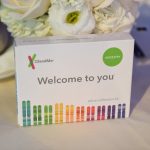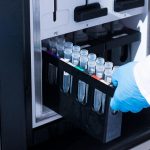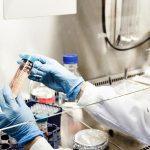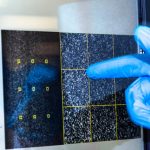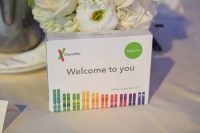23andMe’s Consumer DNA Data Goldmine Is Starting To Pay Off
23andMe’s Consumer DNA Data Gold Mine Is Starting To Pay Off
The consumer genetic testing company says it can barely keep up with demand from researchers, while patient advocates wonder if customers deserve a cut of the profits.
23andMe’s Consumer DNA Data Gold Mine Is Starting To Pay Off
The consumer genetic testing company says it can barely keep up with demand from researchers, while patient advocates wonder if customers deserve a cut of the profits.
Christina Farr August 31, 2016

After decades of inconclusive results, researchers backed by Pfizer and Massachusetts General Hospital revealed that they had identified several genetic markers associated with depression earlier this month. It was the largest study of its kind, using data from more than 120,000 people.
In February, a new paper explored the role that genetics plays on an individual being a morning person or a night owl, and in April another study looked at resilience to Mendelian childhood diseases, such as cystic fibrosis.
Each of these studies used insights gathered from customers of 23andMe, the Google-backed company that makes a direct-to-consumer genetic test kit. Perhaps best known for its battles with regulators over its consumer genetics test in 2013, 23andMe has quietly expanded its business to include brokered access to its database of more than 1 million people’s DNA.
Everyone who uses the company’s $199 test kit receives a request to participate in research. If they agree, their health data is added to a separate database. With 80% of customers consenting, the company has amassed a health data gold mine—and researchers are eager to study it.
23andMe has now hired a team just shy of 70 academics who collaborate with researchers on their studies, many of which are published in top scientific journals. The researchers get access to genetic data coupled with “phenotypic” characteristics or traits, as well as feedback from online surveys. That’s a juicy prospect for researchers.
23andMe is one of a growing number of companies that are developing consumer-friendly tools for researchers, although it is one of a small number focused on genomics. Large academic hospitals like Stanford Medicine and Duke are currently using Apple’s ResearchKit to collect health information via iPhones. Fitbit is also investing in this area: Researchers are increasingly incorporating its step and heart rate data into large population health studies.

Traditionally, clinical trials require raising a large sum of money and recruiting participants to get their genome sequenced, followed by in-person surveys. If a person can’t get to one of the research sites, they won’t be included. That means it’s difficult, and costly, to get large numbers of participants to take part.
23andMe, in contrast, has partially sequenced some 1.2 million genomes already. And it conducts survey via mobile phone, which can be done anytime and almost anywhere.
But despite those advantages, many researchers are still skeptical about the tools used by 23andMe. Not everyone will answer truthfully when asked about their weight or alcohol consumption, for instance—even in the privacy of a mobile phone survey.
“Serious academic researchers, when they have money available, almost always gravitate toward more expensive scientifically advanced tools,” says Matthew Amsden, CEO of ProofPilot, a startup that helps researchers conduct clinical trials. Maxine Mackintosh, a health data researcher at University College London in the U.K., adds that there’s historically been a “discomfort and distrust” among academics with industry collaborations, but that’s starting to change.
23andMe’s research director Joyce Tung admits that it was an uphill battle to convince researchers of the merits of the data, despite that consumers have answered some 350 million survey questions so far. Yet her team’s efforts are starting to bear fruit. “Academics were worried that the quality of the self-reported data wouldn’t be good,” she says, although the company has been experimenting with new ways to improve the accuracy.
For a recent research study related to celiac disease, an autoimmune disorder where eating gluten leads to damage in the small intestine, participants responded in unusually large numbers to say that they had been diagnosed with the disease. Tung chalked that up to the growing trend around gluten-free diets. She didn’t throw out the survey responses, but instead asked a follow-up question (something that 23andMe can easily do, since it doesn’t require another on-site visit): “Have you ever been diagnosed with celiac disease through an intestinal biopsy?” The numbers then dropped to far more realistic levels.
Tung says her team now can hardly keep up with the demand from academics. 23andMe had 25 applications from researchers in the fall of 2013, and that number jumped to 45 in the fall of 2014. The numbers aren’t yet available for 2015 and 2016, but a company spokesman did share that the team received nearly 20 requests from academics to study the data in the wake of the depression study, which was published just two weeks ago.
The company holds biannual meetings to review the applications and determine how many they will collaborate on in given year. The team tends to favor studies on factors that many would be surprised to learn have a genetic component, like taste preferences.
The company also works with an external institutional review board, or “IRB,” agency to determine any potential risks associated with the research and ensure that the participants understand what they’re agreeing to.
The database is now large enough that it’s not all Caucasians with a European background, a group that is typically overrepresented in research. “We are at the point where we can run reasonable genome-wide association studies in non-European groups,” says Tung. That’s a big deal. Studying one ethnic group limits our knowledge about diseases that impact one ethnic group more than another, such as sickle cell anemia.
The company can now also start to research how certain various factors will impact how an individual is likely to respond to a drug. For this kind of research, known as pharmacogenetics, researchers need a massive cohort. Out of 1 million people, only a small number are likely to be taking a certain drug. Of those, a smaller percentage still will be experiencing a side effect. Ideally, researchers would then want to study that by gender, ethnicity, and so on.
Pharma will pay big bucks for that kind of information. While 23andMe is still making most of its money through sales of its consumer testing kit—the price of which increased $100 in October of 2015—its collaborations with drug makers like Genentech (to study Parkinson’s disease) and Pfizer (inflammatory bowel disease and lupus) are a big part of its future growth.
As 23andMe looks to monetize the health data gathered from its consumers, some patient advocates suggest that the company should consider sharing revenues with its participants.
Tung says she has considered some kind of financial incentive in the past, but has some ethical concerns. Her biggest is the potential for coercion: “You can imagine that the level of pressure is unevenly distributed based on economic status,” says Tung. But she hasn’t ruled it out entirely. “We would consider everything that’s ethical and what consumers want.”
Fast Company , Read Full Story
(8)


